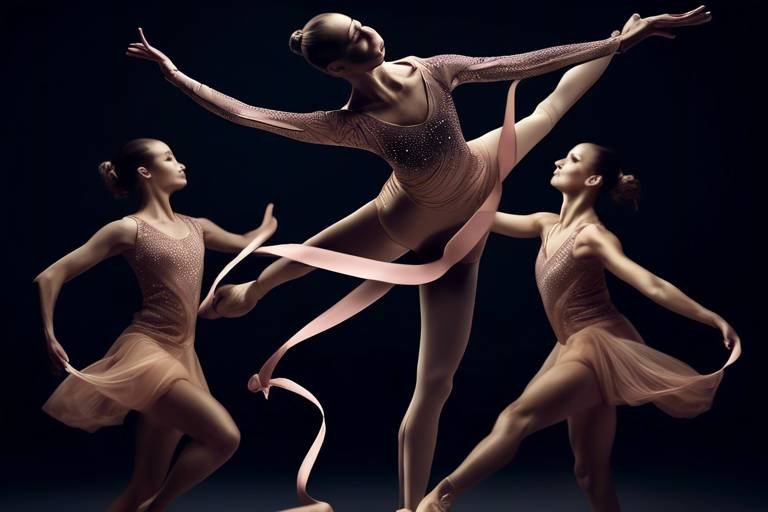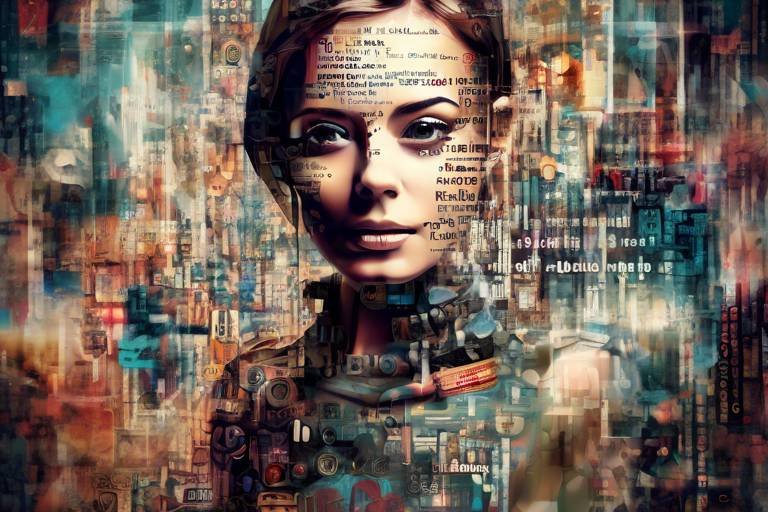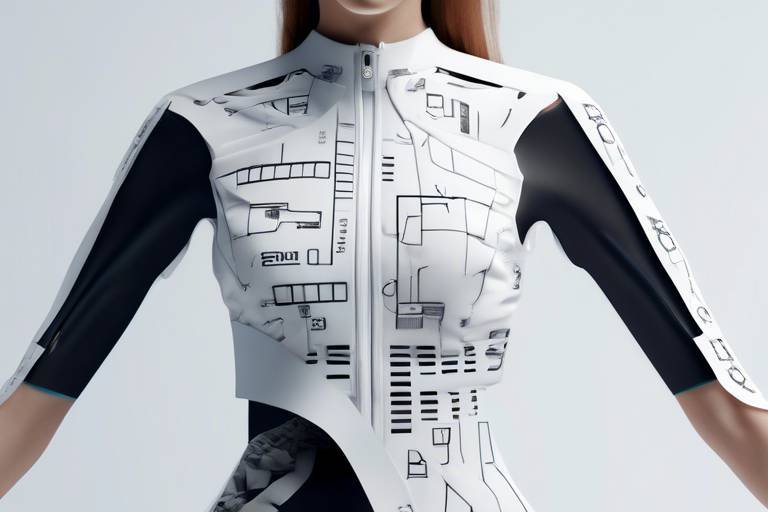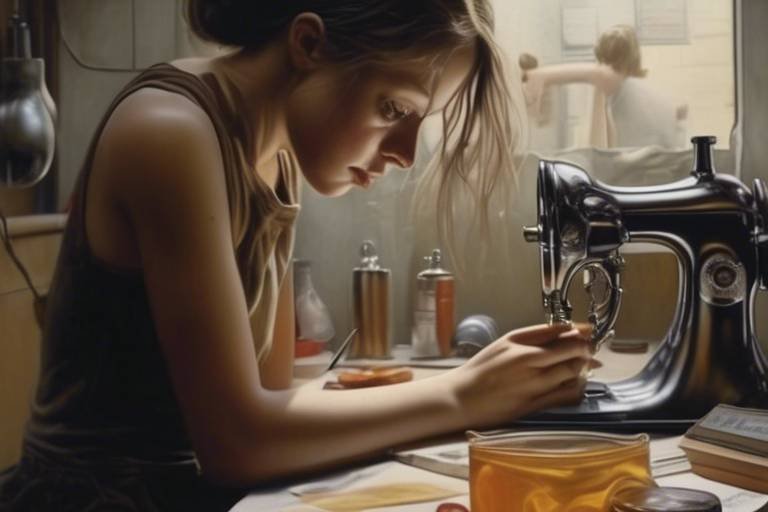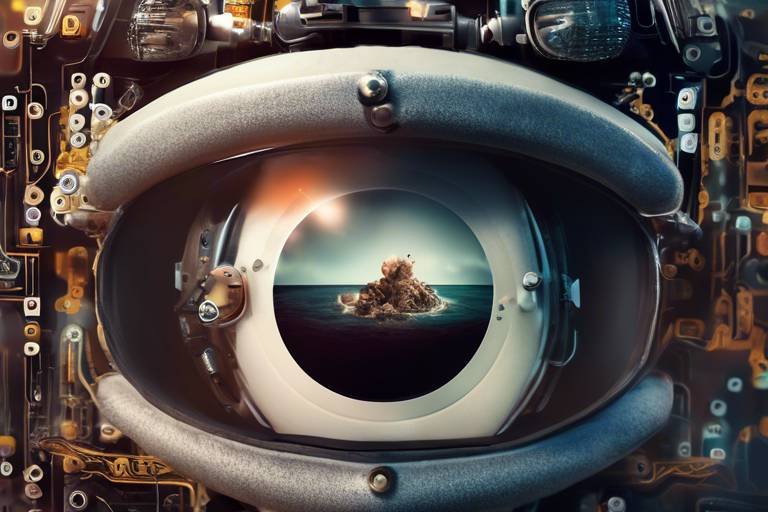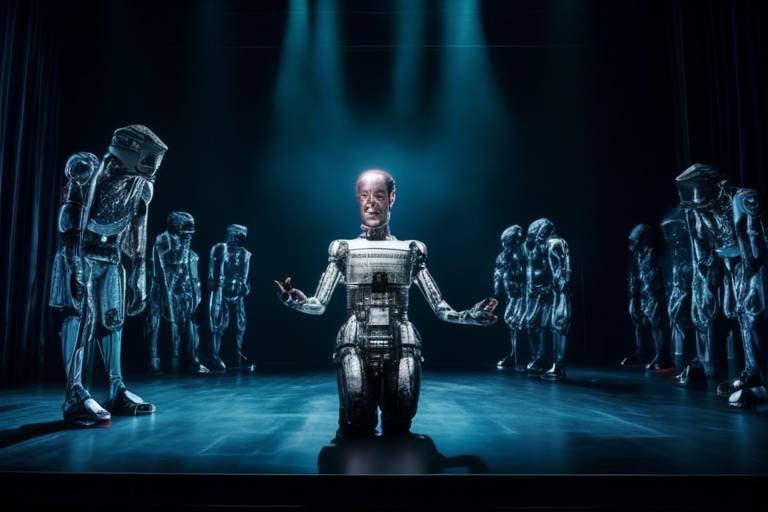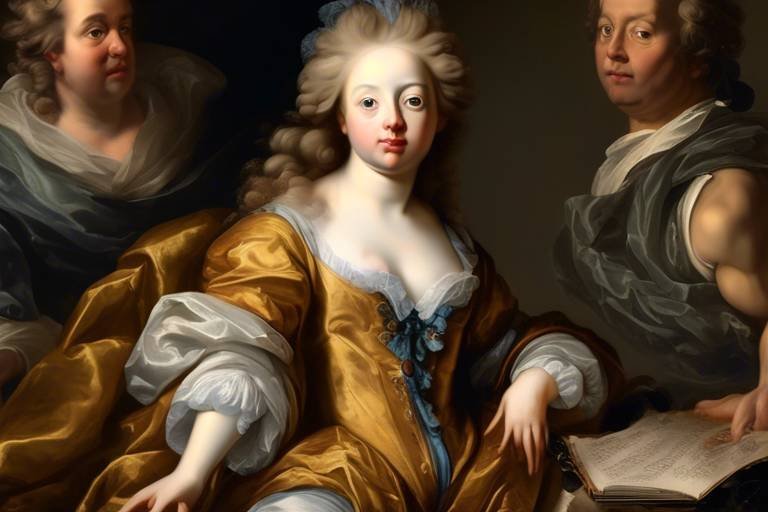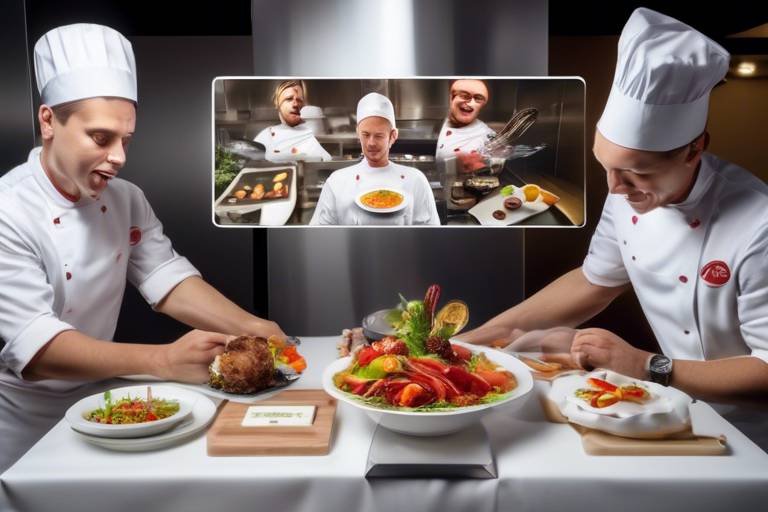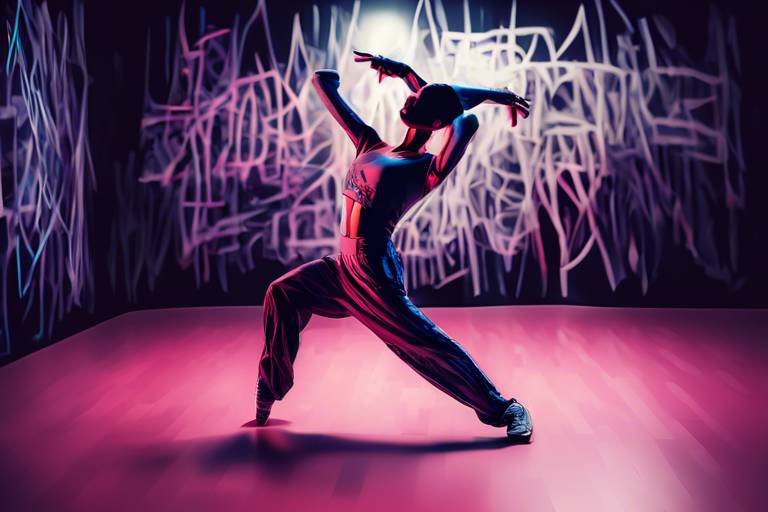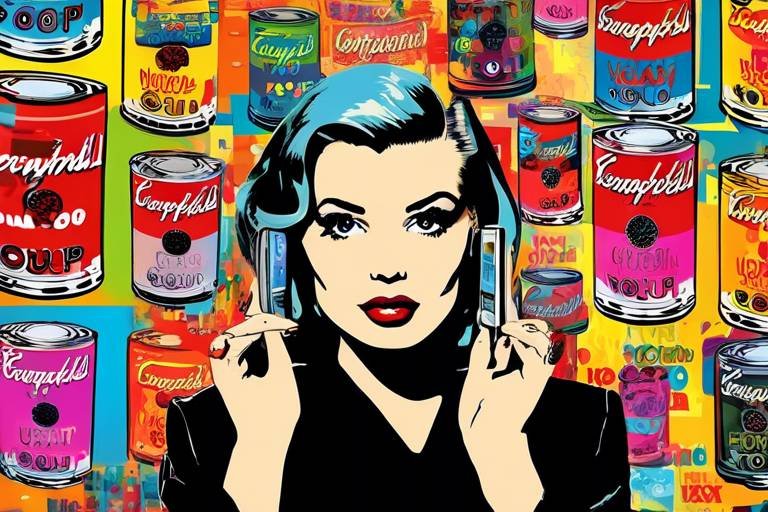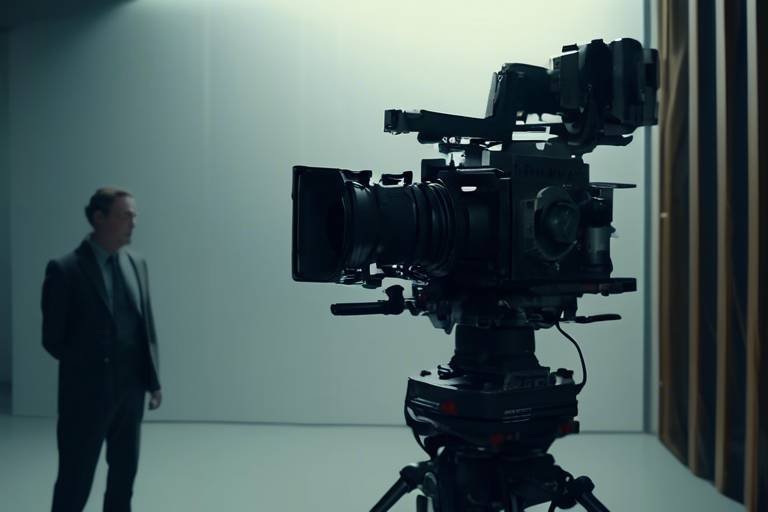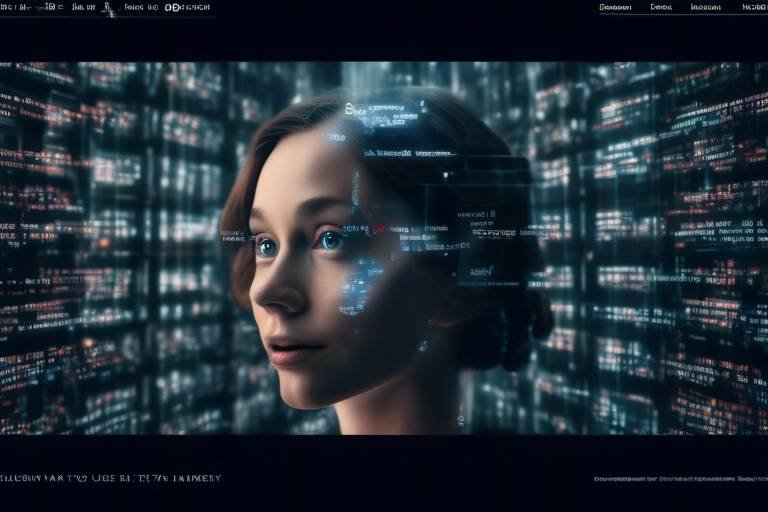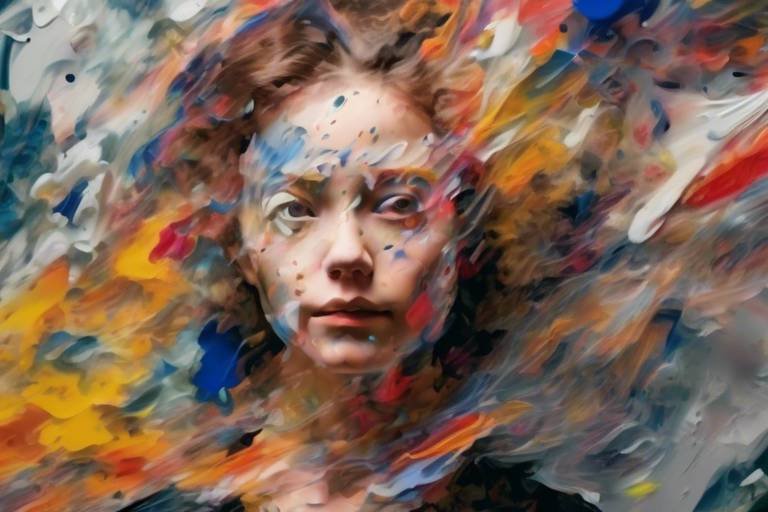The Dawn of AI in Creative Sculptures
The world of sculpture is experiencing a remarkable transformation, one that marries the age-old traditions of artistry with the cutting-edge innovations of artificial intelligence (AI). Imagine walking through a gallery where every piece tells a story not just of the artist's vision but of a collaboration with a machine that thinks and learns. This is not science fiction; it’s the burgeoning reality of modern sculpture. As artists increasingly embrace AI, we are witnessing a renaissance of creativity, where the boundaries of what is possible are being pushed further than ever before.
AI is not merely a tool; it's becoming a partner in the creative process. Traditional sculptors, who once relied solely on their hands and imagination, are now exploring a new frontier. With AI algorithms, they can generate intricate designs and complex forms that were once confined to their dreams. This technology enables artists to visualize their ideas in ways that were previously unimaginable, allowing for a fusion of creativity and computation that breathes new life into the art form.
But what does this mean for the future of sculpture? Is it a threat to the traditional craftsmanship, or does it enhance the artistic journey? As we delve deeper into the impact of AI on sculpture, we will uncover how these innovative techniques are not only transforming the design process but also fostering a collaborative spirit between human creativity and machine intelligence. The implications are vast, and the excitement is palpable. The dawn of AI in creative sculptures is just beginning, and it promises to redefine our understanding of art itself.
In the following sections, we will explore AI-driven design techniques, the fascinating partnerships between artists and machines, and the challenges that come with integrating this technology into traditional art forms. We'll also take a look at how the future of sculpture is shaping up in this AI era, examining emerging technologies and their impact on artistic education. So, buckle up as we embark on this thrilling journey into the future of sculpture!
- How is AI influencing the design process in sculpture? AI algorithms help artists visualize and create complex forms that enhance their artistic expression.
- Are artists losing their creative touch by using AI? No, AI serves as a collaborative partner, enriching the creative process rather than replacing the artist's vision.
- What are some challenges artists face when incorporating AI into their work? Challenges include ethical considerations, technical limitations, and the need for new skills to work effectively with AI tools.
- How will AI shape the future of sculpture? AI is expected to introduce new trends, forms of expression, and innovative techniques that will redefine sculptural art.

AI-Driven Design Techniques
In the world of sculpture, the emergence of artificial intelligence is nothing short of revolutionary. Imagine a sculptor standing before a block of marble, but instead of relying solely on their intuition and experience, they have a digital assistant that can analyze countless forms and structures in seconds. This is the transformative power of AI-driven design techniques. With sophisticated algorithms, sculptors can now explore complex geometries and intricate patterns that were once confined to the realm of imagination.
One of the key benefits of AI in sculpture design is its ability to generate innovative concepts. By inputting parameters such as size, material, and desired aesthetic, artists can leverage AI to produce a variety of design options. This not only speeds up the creative process but also opens up new avenues of exploration. For instance, an artist might input a simple idea of a “flowing form” and watch as the AI generates multiple interpretations, each unique and visually striking.
Furthermore, AI can assist in the optimization of structural integrity. Through simulations and predictive modeling, artists can understand how their sculptures will react to various forces, such as gravity and environmental conditions. This is particularly important for outdoor installations or large-scale works where stability is crucial. By integrating AI into their design process, sculptors can ensure that their creations are not only beautiful but also durable.
Another fascinating aspect of AI-driven design techniques is the ability to analyze historical data. By studying previous sculptures, AI can identify trends and patterns in styles, materials, and techniques. This data can then inform contemporary practices, allowing artists to draw inspiration from the past while pushing the boundaries of what sculpture can be. For example, an AI might analyze the works of renowned sculptors and suggest a fusion of styles that could lead to a groundbreaking new piece.
As we venture deeper into this AI-enhanced world, it’s essential to recognize the collaborative nature of this technology. Sculptors are not merely using AI as a tool; they are engaging in a dialogue with it. This relationship allows for a back-and-forth exchange of ideas, where the artist's vision and the AI's capabilities intertwine. It’s akin to having a creative partner who can offer suggestions and alternatives, helping to refine and elevate the artistic process.
However, this collaboration does come with its own set of challenges. While AI can generate numerous designs, the final decision still rests with the artist. The question arises: how much of the creative process should be left to the machine? This delicate balance between human intuition and machine efficiency is a topic of ongoing discussion in the art community. As sculptors navigate these uncharted waters, they must consider not only the technical aspects of AI but also the philosophical implications of using technology in art.
In conclusion, AI-driven design techniques are reshaping the landscape of sculpture. By enabling artists to explore complex forms, optimize structural integrity, and draw inspiration from historical data, AI is not just a tool but a catalyst for innovation. As sculptors continue to embrace this technology, we can expect to see a new era of creativity that blends the best of human artistry with the limitless possibilities of artificial intelligence.

Collaborative Artistry: Human and Machine
In the ever-evolving landscape of art, the partnership between human creativity and artificial intelligence is creating a fascinating new frontier. Imagine walking into a gallery and seeing a sculpture that not only reflects the artist's vision but also embodies the intricate calculations and algorithms of AI. This synergy is not just a trend; it's a revolution that is redefining what it means to create art. Artists are no longer solo creators but rather collaborators with intelligent machines that can analyze data, generate ideas, and even suggest forms that challenge the boundaries of traditional sculpture.
One of the most exciting aspects of this collaboration is the ability of AI to process vast amounts of information and recognize patterns that may elude even the most skilled human artists. For instance, AI can analyze thousands of existing sculptures, identifying trends in shape, material, and style, and then propose unique designs that blend these elements in innovative ways. This opens up a world of possibilities, allowing artists to explore complex forms and structures that were previously unimaginable. It’s like having a creative partner who can offer a fresh perspective, pushing artists to think outside the box and experiment with their work.
However, this relationship isn't just about efficiency; it's about enhancing the creative process. Artists who embrace AI often find that it inspires them to take risks and explore new avenues of expression. By integrating AI into their workflow, they can focus more on the emotional and conceptual aspects of their work while letting the machine handle the technical complexities. This shift can lead to a more profound artistic experience, where the end result is a fusion of human emotion and machine precision.
For example, consider the work of artists like Refik Anadol and Anna Ridler, who have successfully integrated AI into their sculptural practices. Anadol's installations often utilize algorithms to create mesmerizing visual displays that respond to the environment, while Ridler's work explores the intersection of AI and personal narrative, resulting in sculptures that are both personal and universal. These artists demonstrate how AI can be a powerful tool for expanding the boundaries of creativity, offering new ways to engage audiences and provoke thought.
Yet, this collaboration isn't without its challenges. Artists must navigate the complexities of working with technology, ensuring that their vision is not lost in the process. Moreover, ethical considerations arise when using AI, particularly regarding authorship and originality. Who is the true creator of a piece that is born from a partnership between human and machine? These questions are essential as the art world grapples with the implications of AI in creative practices.
As we look to the future, it’s clear that the collaboration between artists and AI will continue to evolve. The potential for innovative artistic expression is limitless, and as technology advances, so too will the ways in which we create and experience art. This partnership is not just about creating sculptures; it's about reimagining the very essence of creativity itself.
- What is collaborative artistry? Collaborative artistry refers to the partnership between human artists and artificial intelligence, where both contribute to the creative process.
- How does AI enhance the creative process? AI can analyze vast amounts of data, suggest innovative designs, and handle technical complexities, allowing artists to focus on emotional and conceptual elements.
- Are there ethical concerns with AI in art? Yes, issues such as authorship and originality arise when AI contributes significantly to the creation of art.
- Can AI replace human artists? While AI can assist and enhance creativity, it cannot replicate the emotional depth and personal experiences that human artists bring to their work.

Case Studies of Successful Collaborations
In the vibrant intersection of art and technology, several remarkable case studies have emerged, showcasing how artists are harnessing the power of artificial intelligence to create stunning sculptures that challenge our perceptions of creativity. One striking example is the collaboration between renowned sculptor Ernesto Neto and an AI program developed by researchers at the MIT Media Lab. This partnership led to the creation of a series of organic sculptures that mimic the forms found in nature, offering a sensory experience that engages the viewer's emotions and intellect.
Another fascinating case involves the work of Refik Anadol, a media artist who utilizes machine learning algorithms to transform vast datasets into mesmerizing visual sculptures. His project, Archive Dreaming, employed AI to analyze historical artworks, generating new forms that blend the past with the future. This innovative approach not only reflects Anadol's artistic vision but also raises questions about originality and authorship in the age of AI.
Moreover, the collaboration between Daniel Canogar and AI technology exemplifies how artists can utilize machine learning to explore themes of memory and digital culture. Canogar's installation, Data Drift, features sculptures made from discarded electronic devices, enhanced by AI-generated projections that visualize the life cycle of technology. This project not only highlights the environmental impact of our digital consumption but also emphasizes the potential of AI to evoke critical conversations about our relationship with technology.
These collaborations illustrate a broader trend where artists are not merely using AI as a tool but are engaging in a dynamic dialogue with it, challenging the traditional boundaries of sculpture. By integrating AI into their creative processes, these artists are not just creating new forms; they are also redefining what it means to be an artist in the contemporary world. The synergy between human intuition and machine learning opens up endless possibilities, inviting us to rethink the very nature of creativity.
As we observe these groundbreaking projects, it's clear that the future of sculpture is not just about the objects created but also about the conversations they inspire. The integration of AI into the artistic process presents a unique opportunity for artists to explore uncharted territories, pushing the limits of their imagination and inviting audiences to engage with art on a deeper level.
- How does AI influence the creative process in sculpture? AI provides artists with new tools and perspectives, enabling them to explore complex forms and structures that may not have been possible through traditional methods.
- What are some ethical considerations when using AI in art? Artists must consider issues related to authorship, originality, and the potential impact of AI on traditional artistic practices.
- Can AI replace human artists? While AI can assist in the creative process, it is unlikely to replace the unique human touch and emotional depth that artists bring to their work.
- What are some examples of successful artist-AI collaborations? Notable collaborations include Ernesto Neto's organic sculptures, Refik Anadol's data-driven installations, and Daniel Canogar's environmentally conscious works.

Notable Artists Embracing AI
In the ever-evolving landscape of sculpture, a number of visionary artists have begun to embrace artificial intelligence, transforming their creative processes and the art form itself. These pioneers are not just using AI as a tool; they are forging a new path that blends the realms of technology and artistry. One such artist is Refik Anadol, whose work exemplifies the intersection of data and creativity. Anadol utilizes AI algorithms to analyze vast datasets, generating mesmerizing visual sculptures that challenge our perceptions of space and form. His installations often evoke a sense of wonder, inviting viewers to explore the relationship between nature and technology.
Another notable figure is Anna Ridler, who integrates machine learning into her sculptural projects. Ridler's work often revolves around the themes of memory and storytelling, using AI to create dynamic pieces that evolve over time. One of her most acclaimed projects, “Mosaic Virus,” combines traditional techniques with AI-generated patterns, creating a dialogue between the past and the future. This blending of methods not only showcases the potential of AI but also emphasizes the importance of human touch in the creative process.
Additionally, Mario Klingemann stands out in the AI art scene for his exploration of neural networks and generative art. His sculptures often feature intricate designs that are born from algorithms, pushing the boundaries of what sculpture can be. Klingemann’s approach raises fascinating questions about authorship and creativity, as the line between artist and machine blurs. He believes that AI can serve as a collaborator, enhancing the artist's vision rather than replacing it.
As we look at these artists, it becomes clear that the integration of AI into sculpture is not merely a trend; it is a revolution that is reshaping the creative landscape. Each of these artists brings a unique perspective to the table, demonstrating that AI can be a powerful ally in the quest for artistic expression. Their works challenge traditional notions of sculpture, encouraging us to rethink what art can be in an age where machines and humans collaborate.
In conclusion, the contributions of these notable artists highlight the exciting possibilities that arise when we embrace technology in the creative process. As AI continues to evolve, so too will the techniques and concepts that define the future of sculpture. The dialogue between human creativity and artificial intelligence is just beginning, and it promises to be a thrilling journey for artists and audiences alike.
- What is the role of AI in modern sculpture? AI assists artists in exploring new forms and techniques, enabling innovative designs that were previously unimaginable.
- Can AI replace human artists? While AI can enhance creativity, it serves more as a collaborator than a replacement, allowing artists to push their boundaries.
- How do artists ensure the ethical use of AI in their work? Many artists are mindful of the ethical implications and strive to maintain a balance between technology and human creativity.

The Role of AI in Concept Development
In the ever-evolving landscape of art, artificial intelligence is emerging as a powerful ally for sculptors during the concept development phase. Imagine standing at the crossroads of creativity and technology, where the traditional methods of sketching and modeling meet the computational prowess of AI. This synergy is not just a fleeting trend; it's a profound transformation that allows artists to explore a myriad of possibilities that were once confined to their imagination.
When artists begin to conceptualize a new sculpture, they often grapple with a whirlwind of ideas. AI tools can help streamline this chaotic process by providing data-driven insights that inspire and refine their visions. For instance, AI algorithms can analyze existing artworks, identifying patterns and styles that resonate with the artist’s intent. This analysis can lead to unexpected revelations about form, texture, and composition, enabling artists to push their creative boundaries.
Moreover, AI can facilitate the generation of 3D models based on initial sketches or ideas. By using advanced algorithms, artists can input their basic concepts into AI systems, which then produce multiple variations of the design. This not only saves time but also opens the door to innovative approaches that artists might not have considered. The result? A collaborative dance between human creativity and machine learning that leads to breathtaking sculptures.
One fascinating aspect of AI in concept development is its ability to simulate environmental factors. Imagine an artist creating a sculpture intended for outdoor display. AI can model how the piece will interact with sunlight, shadows, and weather conditions, offering insights that can significantly influence the final design. This capability allows artists to make informed decisions, ensuring their sculptures not only look stunning but also endure the test of time.
Additionally, AI can assist in material selection. Sculptors often face the challenge of choosing the right materials that align with their vision and the intended impact of their work. AI systems can analyze the properties of various materials and suggest the best options based on factors such as durability, texture, and aesthetic appeal. This data-driven approach empowers artists to make choices that enhance their artistic expression.
As we delve deeper into the role of AI in concept development, it's essential to recognize that this technology does not replace the artist's intuition or emotional connection to their work. Instead, it serves as a catalyst for creativity, enabling artists to explore uncharted territories while retaining their unique voice. The collaboration between human and machine is akin to a conversation where both parties contribute, resulting in a richer and more dynamic artistic process.
In conclusion, the integration of AI into the concept development phase of sculpture is a game-changer. It not only enhances creativity but also equips artists with the tools they need to navigate the complexities of modern artistic expression. As we continue to witness this evolution, one can only wonder: what remarkable sculptures will emerge from the minds of artists who dare to embrace this technology?

Challenges of AI in Sculpture
As we venture into the realm of artificial intelligence in sculpture, it's crucial to recognize that this innovative technology brings with it a set of challenges that artists must navigate. While AI has the potential to revolutionize the creative process, it also poses significant hurdles that can complicate the relationship between human creativity and machine intelligence. One of the most pressing concerns is the ethical implications of using AI in art. Questions arise about authorship and originality: if an AI generates a sculpture, who is the true artist? Is it the programmer, the machine, or the artist who conceptualized the idea? This dilemma can create friction within the artistic community, leading to debates about the value of human creativity versus machine-generated work.
Another challenge lies in the technical limitations of AI itself. While algorithms can analyze vast amounts of data and suggest design options, they lack the emotional depth and intuition that human artists bring to their work. AI can produce stunning visuals, but it often struggles to capture the underlying narratives or sentiments that make art resonate with viewers. Artists may find themselves in a tug-of-war between relying on AI for efficiency and maintaining their unique voice and vision.
Moreover, the integration of AI into the sculptural process can be a steep learning curve. Many artists may not possess the technical skills required to effectively harness AI tools, leading to a sense of alienation from their own medium. This gap can create a divide where only a select few artists, often those with a background in technology, can fully exploit the capabilities of AI, potentially sidelining traditional sculptors who may not be as tech-savvy.
Lastly, there is the issue of accessibility. Not all artists have the resources to invest in advanced AI technologies, which can be costly and complex. This disparity can lead to an uneven playing field in the art world, where only those with financial backing can afford to experiment with cutting-edge tools, leaving many talented artists behind. As we navigate these challenges, it becomes essential to foster an inclusive environment that encourages collaboration between artists and technologists, ensuring that the future of sculpture remains diverse and vibrant.
- What are the ethical concerns surrounding AI in sculpture?
Ethical concerns primarily revolve around authorship and originality. When AI generates a sculpture, questions arise about who should be credited as the artist. - Can AI truly replicate human creativity?
While AI can produce impressive designs, it often lacks the emotional depth and intuition that human artists bring to their work, making it difficult for AI to fully replicate human creativity. - How can artists learn to use AI in their work?
Artists can explore workshops, online courses, and collaborative projects with technologists to gain the skills needed to effectively integrate AI into their artistic process. - Is AI technology accessible to all artists?
Access to AI technology can vary significantly. While some artists may have the resources to invest in advanced tools, others may find it challenging to access these technologies.

The Future of Sculpture in an AI Era
The intersection of art and technology has always been a fascinating realm, but with the advent of artificial intelligence, the future of sculpture is poised for a radical transformation. Imagine walking into a gallery where every piece of art not only tells a story but also interacts with the viewer in real-time. This is not just a dream; it's a glimpse into what the future holds. AI is not merely a tool for artists; it is becoming a co-creator, pushing the boundaries of what we consider possible in sculptural art.
As we look ahead, we can anticipate several key trends that will shape the landscape of sculpture in the AI era. Firstly, the integration of 3D printing technology will allow artists to create intricate designs that were once limited by manual techniques. This technology enables the production of complex structures with precision and efficiency, opening up a world of possibilities for sculptors. For instance, sculptures that incorporate organic shapes or detailed textures can be produced with ease, allowing artists to experiment without the constraints of traditional materials.
Moreover, virtual reality (VR) is set to revolutionize how we experience sculpture. Imagine donning a VR headset and stepping into a digital environment where you can manipulate sculptures as if they were made of clay. This immersive experience not only enhances the viewer's engagement but also provides artists with a new platform to showcase their work. Artists can create virtual sculptures that exist solely in the digital realm, challenging the notion of what a sculpture can be.
Another exciting development is the emergence of AI-driven art critiques. As artists create their pieces, AI can analyze their work in real-time, offering feedback based on established art principles and even suggesting improvements. This kind of collaboration can enhance an artist's ability to refine their vision and push their creative boundaries. It’s like having a mentor who’s available 24/7, providing insights that can elevate the artist's work to new heights.
However, with these advancements come important considerations. The role of artistic education is evolving. Future artists will need to be well-versed not only in traditional sculpting techniques but also in digital tools and AI applications. Educational institutions are beginning to integrate these technologies into their curricula, preparing students to navigate the complexities of a tech-enhanced artistic landscape. The question arises: how will these changes affect the essence of creativity? Will the human touch be lost in the process?
In conclusion, the future of sculpture in an AI era is filled with endless possibilities. As artists embrace new technologies, we will witness a fusion of creativity and innovation that challenges our perceptions of art. The sculptures of tomorrow may not only be visually stunning but also intellectually engaging, inviting us to ponder the relationship between human creativity and artificial intelligence. Are we ready to embrace this new era of artistic expression?
- Will AI replace traditional sculptors?
No, AI is intended to enhance the creative process, not replace the artist's unique vision and skills. - How can artists learn to use AI in their work?
Many educational institutions offer courses on digital art and AI applications, and there are numerous online resources available. - What are the ethical implications of using AI in art?
As AI becomes more integrated into the creative process, questions around authorship, originality, and the role of the artist will need to be addressed.

Emerging Technologies in Sculpture
As we stand on the brink of a new era in the world of sculpture, it’s fascinating to witness how emerging technologies are reshaping this age-old art form. Imagine walking through a gallery filled with sculptures that not only challenge our perception of art but also push the boundaries of what we thought was possible. With advancements in 3D printing, virtual reality, and augmented reality, artists are now equipped with tools that allow them to create intricate designs and forms that were once confined to the realm of imagination.
One of the most exciting developments is the rise of 3D printing technology. This process allows artists to materialize their visions with remarkable precision. Instead of traditional carving or molding, artists can design their sculptures digitally and then print them layer by layer. This not only saves time but also opens up a world of possibilities for intricate details and complex geometries that would be nearly impossible to achieve by hand. For instance, artists can now create organic shapes that mimic nature, resulting in sculptures that seem to flow and breathe.
Moreover, virtual reality (VR) has emerged as a game-changer in the sculptural landscape. With VR, artists can step into a digital realm where they can sculpt in a three-dimensional space. This immersive experience allows for a unique approach to sculpture, where the artist can manipulate their creation from every angle, providing a deeper understanding of form and structure. Imagine wearing a VR headset and molding a sculpture that exists only in the virtual world, then bringing it to life in the physical realm through 3D printing. It’s like having a magic wand that transforms dreams into tangible art!
In addition to VR, augmented reality (AR) is also making waves in the sculpture scene. Artists can overlay digital elements onto physical sculptures, creating a hybrid experience that engages viewers in new ways. For example, a sculpture could be enhanced with AR animations that tell a story or provide context, allowing the audience to interact with the artwork in a dynamic fashion. This fusion of the digital and physical worlds not only captivates the imagination but also invites deeper engagement from the audience.
As we explore these technologies, it’s essential to acknowledge the role of artificial intelligence (AI) in sculptural innovation. AI can analyze vast amounts of data to assist artists in generating designs that are both unique and complex. By using algorithms, artists can experiment with forms and structures that may not have been conceived through traditional methods. This collaboration between human creativity and machine learning results in a new wave of sculptures that challenge our understanding of art and creativity.
However, with all these advancements comes a need for artists to adapt and learn. Art education is evolving to incorporate these technologies, ensuring that the next generation of sculptors is well-equipped to navigate this tech-enhanced landscape. Educational institutions are beginning to offer courses that focus on digital sculpting, 3D modeling, and the integration of AI in the creative process, preparing students for a future where technology and art coexist harmoniously.
In conclusion, the emergence of these technologies is not just a trend; it represents a profound shift in the way we create and experience sculpture. As artists continue to explore the possibilities offered by 3D printing, VR, AR, and AI, we can expect to see a flourishing of creativity that redefines the boundaries of sculptural art. The future is indeed bright for sculpture, and it’s exciting to think about where this journey will lead us!
- What is 3D printing in sculpture? 3D printing in sculpture is a technology that allows artists to create three-dimensional objects by printing them layer by layer from digital designs.
- How does virtual reality enhance sculpting? Virtual reality allows artists to sculpt in a three-dimensional digital space, providing a unique and immersive experience that helps them visualize and manipulate their work from all angles.
- What role does AI play in modern sculpture? AI assists artists in generating complex designs and exploring new forms by analyzing data and suggesting innovative ideas that push the boundaries of traditional sculpting.
- Are there any challenges associated with these technologies? Yes, while these technologies offer exciting opportunities, artists may face challenges such as technical limitations, the need for new skills, and ethical considerations regarding the use of AI in creative processes.

Impact on Artistic Education
The rise of artificial intelligence in the world of sculpture is not just reshaping the art itself, but it's also having a profound impact on artistic education. As AI becomes an integral part of the creative process, educational institutions are adapting their curricula to prepare future artists for a landscape that blends traditional techniques with cutting-edge technology. Imagine walking into a classroom where students are not only learning how to mold clay or chisel stone but are also engaging with AI algorithms to explore new forms and ideas. This fusion of art and technology opens up a world of possibilities.
Art schools are now incorporating AI-driven tools into their programs, allowing students to experiment with design software that can generate complex forms and structures. This hands-on experience is essential because it teaches students to think critically about how technology can enhance their creative vision. For instance, students might use AI to generate multiple iterations of a sculpture concept, selecting the most compelling design based on data-driven insights. This method not only fosters creativity but also encourages a data-informed approach to artistic decision-making.
Moreover, educators are recognizing the importance of collaboration between artists and technologists. Workshops and courses are being designed to promote interdisciplinary learning, where students can work alongside computer scientists and engineers. This collaborative spirit helps break down the barriers between disciplines, allowing for a richer educational experience. Imagine a student sculptor working with a programmer to create an interactive installation that responds to viewer movements—this is the future of artistic expression!
However, it's not just about the technical skills. The integration of AI in art education also raises critical discussions about authorship, ethics, and the role of the artist. Students are encouraged to grapple with questions like: "If an AI generates a sculpture, who is the true artist?" and "What ethical considerations should we keep in mind when using AI in creative processes?" These discussions are crucial in shaping a new generation of artists who are not only skilled but also socially aware and ethically responsible.
To illustrate this shift, let’s take a look at some of the key elements that are becoming part of the artistic education landscape:
| Key Elements | Description |
|---|---|
| AI Tools in Curriculum | Integration of AI software that assists in design and concept development. |
| Interdisciplinary Learning | Collaboration between art students and tech professionals to foster innovation. |
| Ethics and Authorship | Discussions on the implications of AI in art, focusing on ownership and responsibility. |
| Hands-On Experience | Practical workshops using AI tools to create and critique art. |
As we look to the future, it's clear that artistic education is evolving to embrace these changes. Schools are not just teaching students to create; they are preparing them to navigate a world where art and technology coexist harmoniously. The artists of tomorrow will be equipped with a unique skill set that allows them to innovate and express themselves in ways we can only begin to imagine. The question remains: are we ready to embrace this new era of artistic expression?
- How is AI changing the way art is taught?
AI is being integrated into art curricula, allowing students to use advanced tools for design and concept development, fostering creativity and technical skills. - What ethical concerns arise from using AI in art?
Questions about authorship, ownership, and the role of the artist are central to discussions about AI in creative processes. - Are there specific AI tools recommended for art students?
Yes, various AI design software and generative art tools are being introduced in classrooms to help students explore new creative possibilities. - Will traditional art forms still be relevant?
Absolutely! Traditional techniques will continue to coexist with AI, enriching the artistic landscape rather than replacing it.
Frequently Asked Questions
- How is AI transforming the field of sculpture?
AI is revolutionizing sculpture by introducing innovative design techniques that allow artists to explore complex forms and structures that were previously unimaginable. Through AI algorithms, sculptors can experiment with new materials and methods, pushing the boundaries of creativity.
- What are some examples of successful collaborations between artists and AI?
There are several inspiring case studies where artists have integrated AI into their work. For instance, artists have used AI to generate unique design concepts that they then bring to life in their sculptures. These collaborations not only enhance creativity but also challenge traditional notions of authorship in art.
- Are there any challenges associated with using AI in sculpture?
Yes, while AI offers many benefits, artists face challenges such as ethical considerations and technical limitations. Questions arise about the role of the artist versus the machine, and there can be a steep learning curve when it comes to mastering new technologies.
- How does AI assist in the concept development stage of sculpture?
AI plays a significant role in concept development by providing artists with new perspectives and insights. It can analyze existing works and trends to suggest innovative ideas, helping artists refine their visions before starting the physical creation process.
- What does the future hold for sculpture in an AI-driven world?
The future of sculpture is likely to be shaped by emerging technologies such as 3D printing and virtual reality. These advancements will open up new avenues for artistic expression and enable artists to create works that were once thought impossible.
- How is art education adapting to the rise of AI in sculpture?
Art education is evolving to prepare the next generation of artists for a tech-enhanced creative environment. Schools are incorporating AI tools into their curricula, teaching students how to leverage technology in their artistic practices while maintaining their unique voices.


